- Home
- US $20 Bill
United States 20 Dollar Bill: Complete History From 1861 to Present
The United States 20 Dollar Bill has been issued in many different types and designs over the years since 1861.
You need to be a serious collector when it comes to the $20 denomination, compared to smaller denominations, and have plenty of resources to achieve a complete collection.
Both large and small sized notes are great for collecting, although some large size Treasury Notes and Silver Certificates may have become too expensive for the average collector.
Here is a list of all the different issues both large and small:
Large Size Series $20 Bills
- Demand Note 1861
- Legal Tender Note 1862, 1863, 1869, 1875, 1878, 1880
- Interest Bearing Note 1863
- Gold Certificate 1863, 1882, 1905, 1906, 1922
- Compound Interest Treasury Note 1864
- National Bank Note 1865, 1875, 1882, 1902
- National Gold Bank Note 1870, 1872, 1873, 1874, 1875
- Silver Certificate 1878, 1880, 1886, 1891
- Treasury Note (Coin) 1890, 1891
- Federal Reserve Note 1914
- Federal Reserve Bank Note 1915, 1918
Small Size Series $20 Bills
- Gold Certificate 1928
- Federal Reserve Note 1928, 1934, 1950, 1963, 1969, 1974, 1977, 1981, 1985, 1988, 1990, 1993, 1995, 1996, 1999, 2001, 2004, 2006, 2009, 2013, 2017
- National Bank Note 1929
- Federal Reserve Bank Note 1929
$20 Demand Note 1861
The first United States 20 dollar bill issued August 1861 to April 1862 was called a Demand Note.
At that time, the US needed more money to pay for things during the American Civil war. For example, to pay the people who worked for the government and the soldiers.
These Demand Notes had a unique look. On the back, they had green colored ink, which was different from other money at that time.
This is where the term Greenbacks originated.
On the front was an image of Lady Liberty holding a sword and shield.
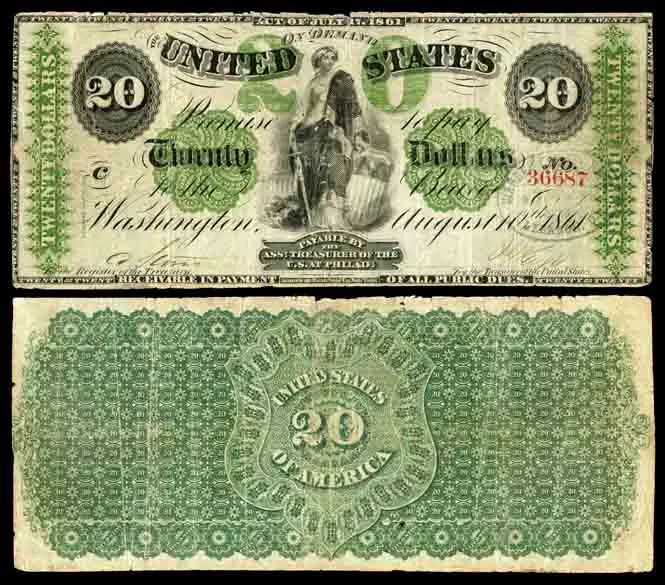
Image Courtesy of National Numismatic Collection, National Museum of American History. (Unedited CC)
These notes were issued for the banks of New York, Philadelphia, Boston, Cincinnati and St. Louis.
Any Demand Notes with the 'For the' handwritten as opposed to engraved are very rare and worth a lot of money.
$20 Legal Tender Note Series of 1862 & 1863
The next $20 bill to be released from 1862 to 1971 was the United States Note which was authorized by the First Legal Tender Act.
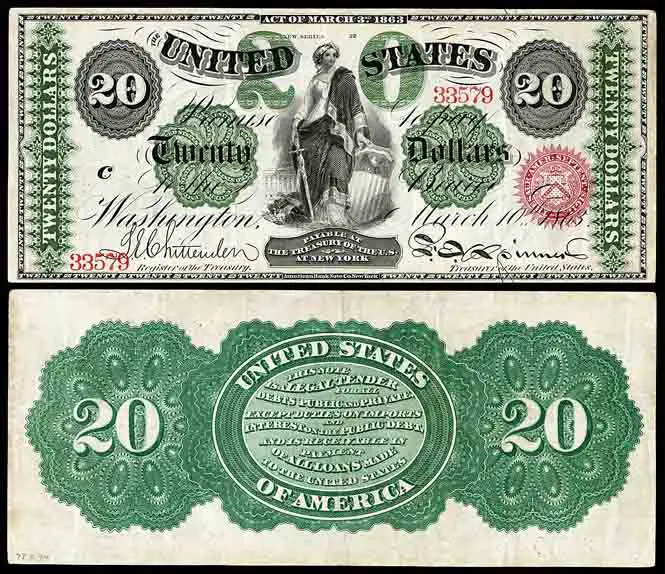
Image Courtesy of National Numismatic Collection, National Museum of American History. (Unedited CC)
It was also called the Legal Tender Note and has been the longest issued form of paper currency in the United States.
They only stopped issuing them in 1971 and any existing US notes that you may encounter are still legal tender.
These large sized notes have the obligation on the reverse which reads, "This Note is a Legal Tender for all debts public and private except Duties on Imports and Interest on the Public Debt; and is receivable in payment of all loans made to the United States."
$20 Legal Tender Note Series of 1869
The twenty dollar United States note was redesigned in 1869 and nicknamed the Rainbow Note due to the vivid coloring on the obverse.
It features the portrait of Alexander Hamilton on the left side of the obverse and Victory holding a sword and shield on the right.
The reverse is still colored green with a slightly different design.
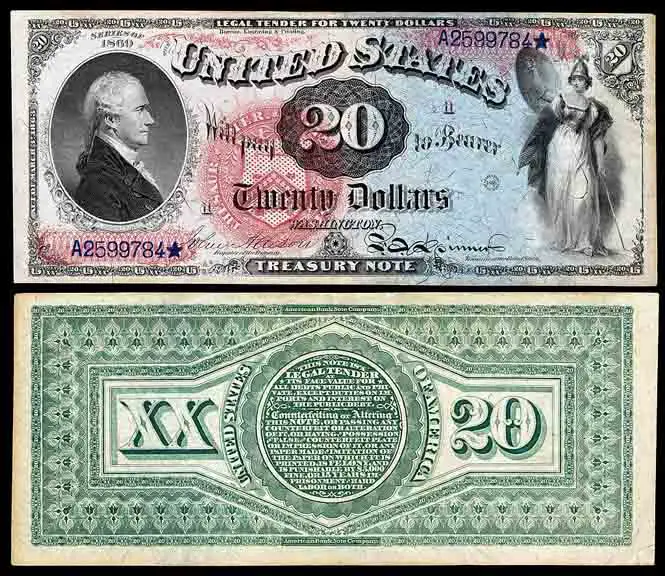
Image Courtesy of National Numismatic Collection, National Museum of American History. (Unedited CC)
This design was changed slightly in 1875 with the reverse being overhauled. The obverse stayed much the same and this iteration is known as Fr-128.
The series of 1880 was also very similar to 1875 and was cataloged as Fr-145.
$20 Gold Certificate Series of 1863
These very rare gold certificates were first authorized by the US government in 1863 and issued throughout the mid to late 1860's.
It is thought that probably less than ten of these certificates still exist.
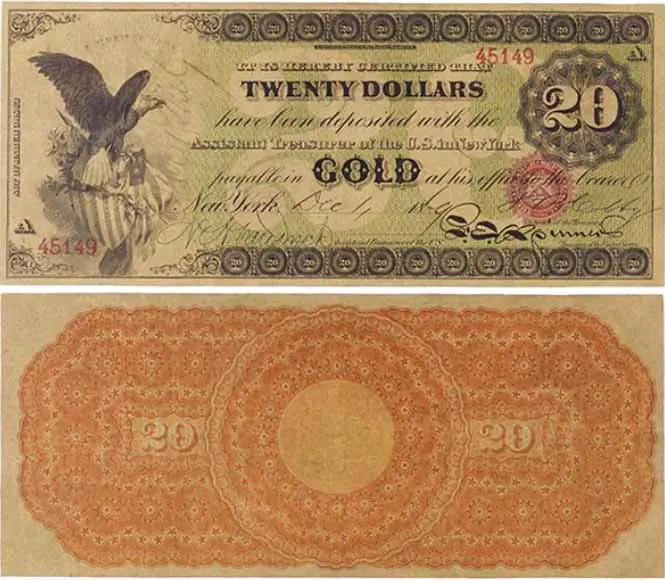
Image Courtesy of PMG Notes
They were backed by actual gold and used for inter-bank transactions until 1933 when private ownership of Gold Certificates was outlawed by Franklin D. Roosevelt.
$20 Gold Certificate Series of 1882
The Gold Certificate has a new design. On the right side of the obverse is a portrait of James Garfield who was the 20th President of the United States.
The reverse is still orange with an image of an Eagle in the center.
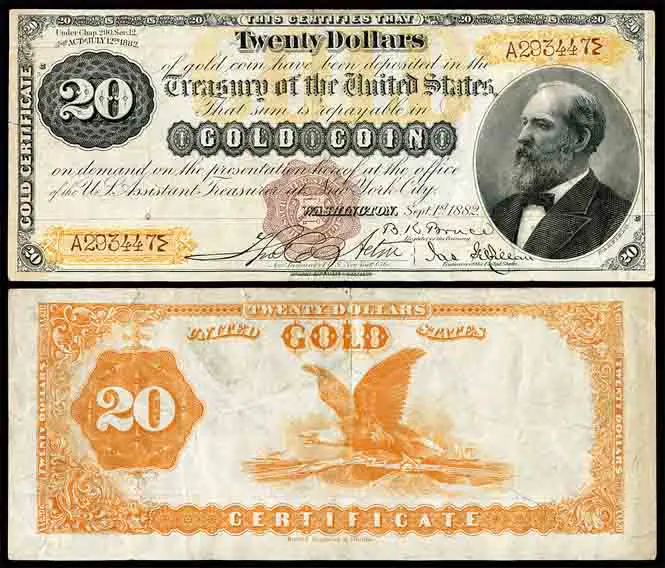
Image Courtesy of National Numismatic Collection, National Museum of American History. (Unedited CC)
$20 Gold Certificate Series of 1905
The 1905 Gold Certificate design has George Washington, the first President of the United States, on the obverse and the reverse depicts the Seal of the United States of America in orange ink.
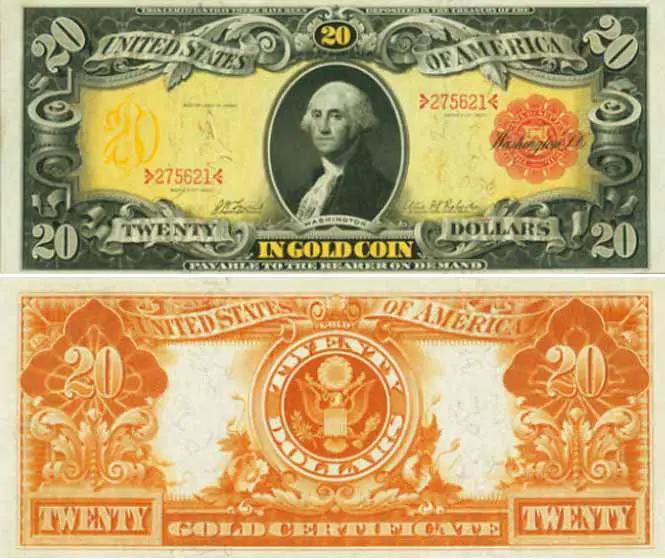
Image Courtesy of Heritage Auctions
$20 National Bank Note Series of 1865 & 1875
The National Bank Notes issued between 1865 and 1875 were known as the original or old series and were issued during the First Charter period.
They were authorized by the National Bank Act of February 25, 1863 and their design was the same for all issuing banks.
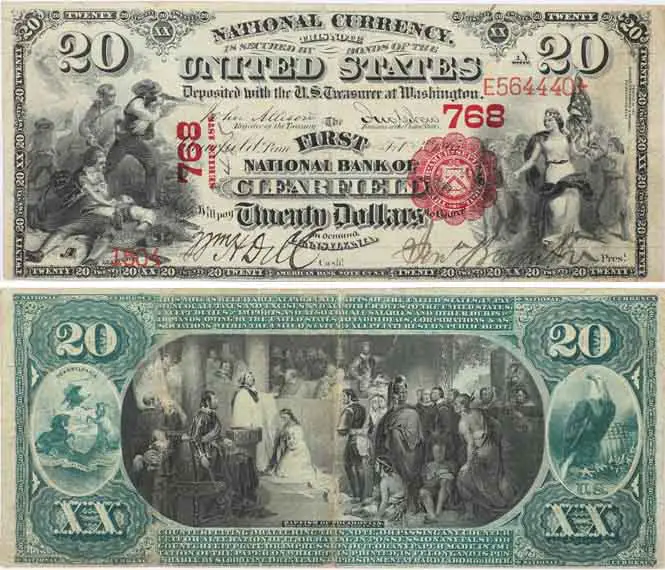
Image Courtesy of National Numismatic Collection, National Museum of American History. (Unedited CC)
On the obverse left was The Battle of Lexington and on the right, Columbia carrying a flag and leading a procession.
The reverse depicted the Baptism of Pocahontas.
This note was issued by the First National Bank of Clearfield, Pennsylvania and was printed by a private company with the BEP doing the final processing.
$20 National Bank Note Series of 1882
The series 1882 National Bank Note was released as the first issue of the second charter.
Bank charters were extended for another 20 years by the Act of July 12, 1882.
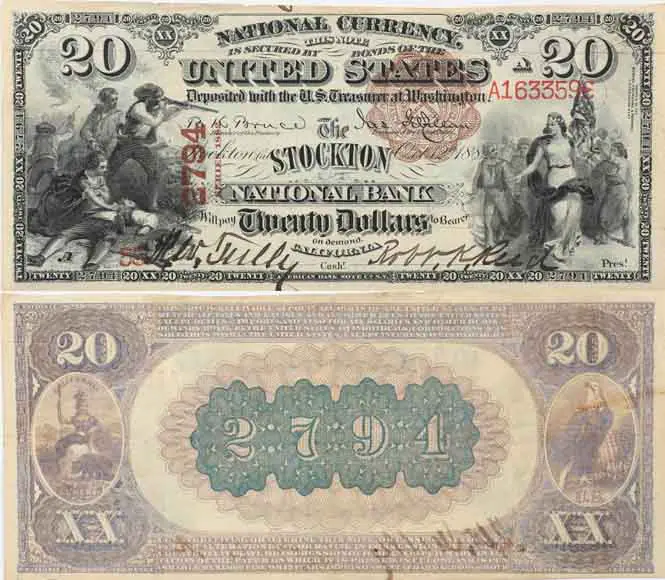
Image Courtesy of National Numismatic Collection, National Museum of American History. (Unedited CC)
$20 National Bank Note Series of 1902
The series 1902 National Bank Note was released as the first issue of the third charter.
Bank charters were extended again by the Act of April 12, 1902.
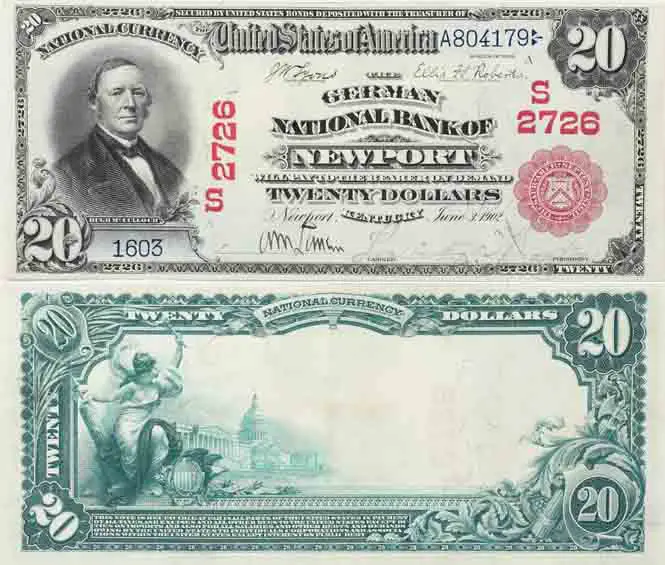
Image Courtesy of National Numismatic Collection, National Museum of American History. (Unedited CC)
$20 Silver Certificate Series of 1878 & 1880
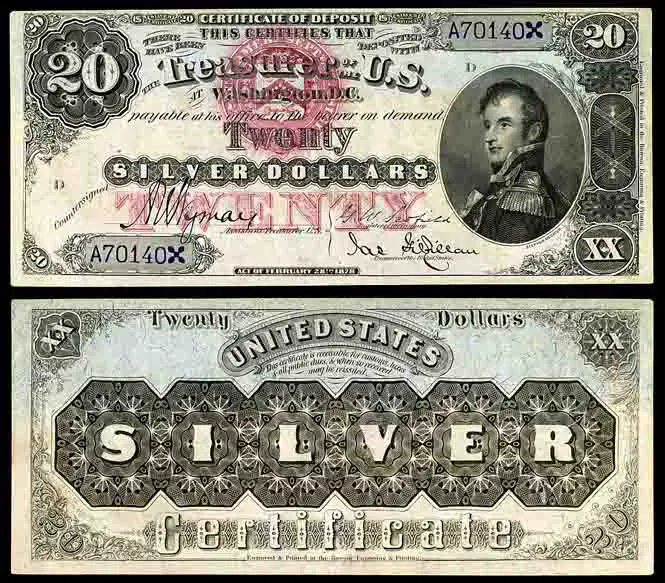
Image Courtesy of National Numismatic Collection, National Museum of American History. (Unedited CC)
Silver Certificates are a representative paper currency that are redeemable for silver dollar coins to their face value.
They are still legal tender today and accepted as a form of currency at their face value. Although, they are worth much more to Numismatists.
On the obverse is Stephen Decatur Jr. who was an American naval officer.
$20 Silver Certificate Series of 1886
A new Twenty Dollar Silver Certificate was released in 1886 with the portrait of Daniel Manning on the obverse.
Daniel Manning was the 37th Secretary of the Treasury.
The reverse was changed to a new design that was now colored green.
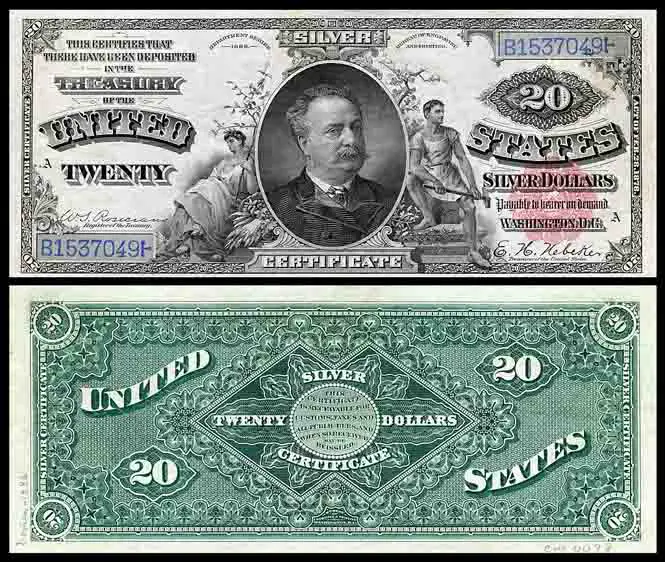
Image Courtesy of National Numismatic Collection, National Museum of American History. (Unedited CC)
$20 Treasury Coin Note Series of 1890
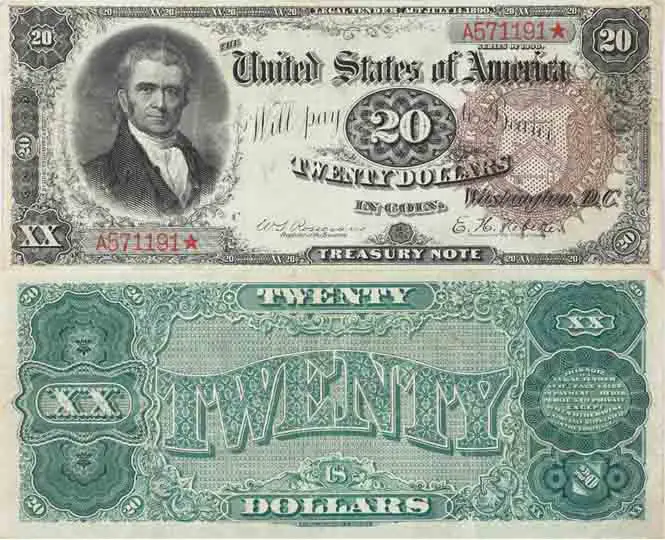
Image Courtesy of National Numismatic Collection, National Museum of American History. (Unedited CC)
The Treasury Note Act of 1890 authorized the issue of Treasury Coin Notes.
The Act was also known as the Sherman Silver Purchase Law and the first note had a bust of John Marshall on the obverse.
John was the fourth chief justice of the United States. The law was later deemed a failure and was repealed.
$20 Federal Reserve Note Series of 1914
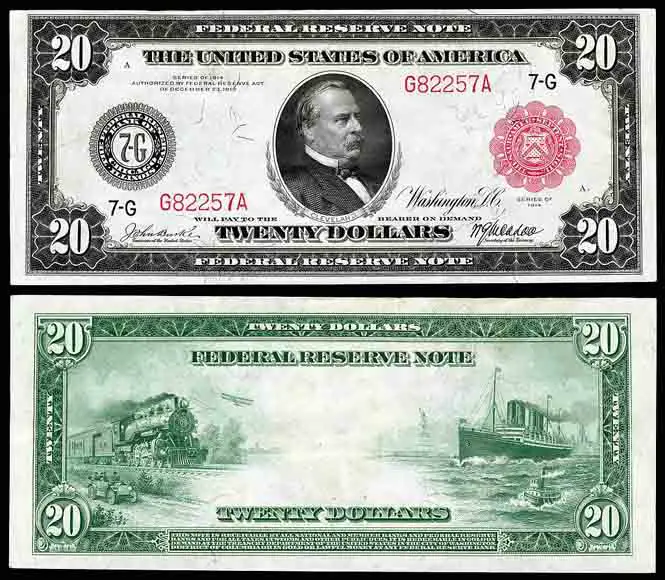
Image Courtesy of National Numismatic Collection at the Smithsonian Institution. (Unedited CC)
1914 was the first year that the Federal Reserve Note was issued. These initial notes were known as large size.
They were produced by the Bureau of Engraving and Printing under the authority of the Federal Reserve Act 1913.
The 1914 $20 bill was issued with a red seal or a blue seal and featured the bust of Grover Cleveland on the obverse.
On the reverse was a steam locomotive, a steamship and an automobile. You can also see the Statue of Liberty and an airplane.
$20 Federal Reserve Bank Note Series of 1915
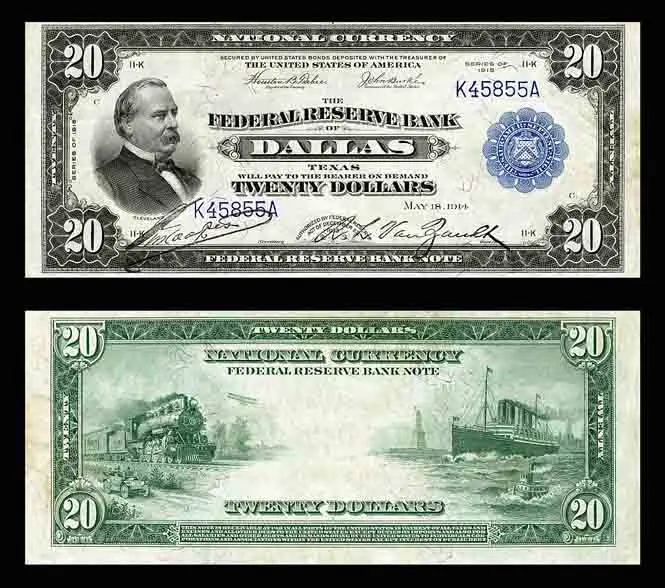
Image Courtesy of National Numismatic Collection at the Smithsonian Institution. (Unedited CC)
These bills are very scarce as they were only made for handful of banks.
The 1915 $20 bill was issued by Atlanta, Chicago, Kansas City and Dallas.
On the obverse it features a portrait of Glover Cleveland on the left side, a blue seal on the right and the name of the issuing bank in the center.
The reverse was similar to the 1914 FRN, but instead the writing in the center reads: NATIONAL CURRENCY, FEDERAL RESERVE BANK NOTE.
$20 Federal Reserve Bank Note Series of 1918
The 1918 series obverse looks very similar to the 1915 series and the reverse is identical.
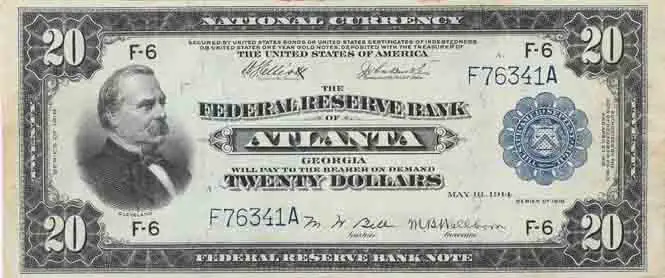
Image Courtesy of National Numismatic Collection at the Smithsonian Institution. (Unedited CC)
They were only issued by the banks of Atlanta and St. Louis and are very valuable in any condition.
You could expect to get around $1600 for something as low as a grade VG-8 because these FRBN's are so rare.
If you look closely you can see that the series year has moved from above the seal on the series of 1915 to below the seal and beside the date on the series of 1918.
The obligation as the top of the obverse has changed too.
The series of 1915 reads, "SECURED BY UNITED STATES BONDS DEPOSITED WITH THE TREASURER OF THE UNITED STATES OF AMERICA."
The series of 1918 reads, "SECURED BY UNITED STATES BONDS OR UNITED STATES CERTIFICATES OF INDEBTEDNESS OR UNITED STATES ONE-YEAR GOLD NOTES, DEPOSITED WITH THE TREASURER OF THE UNITED STATES OF AMERICA."
On the far right of the 1918 $20 note it also reads, "AUTHORIZED BY THE ACTS OF DECEMBER 23, 1913, AND APRIL 23, 1918."
$20 Federal Reserve Note Series of 1928
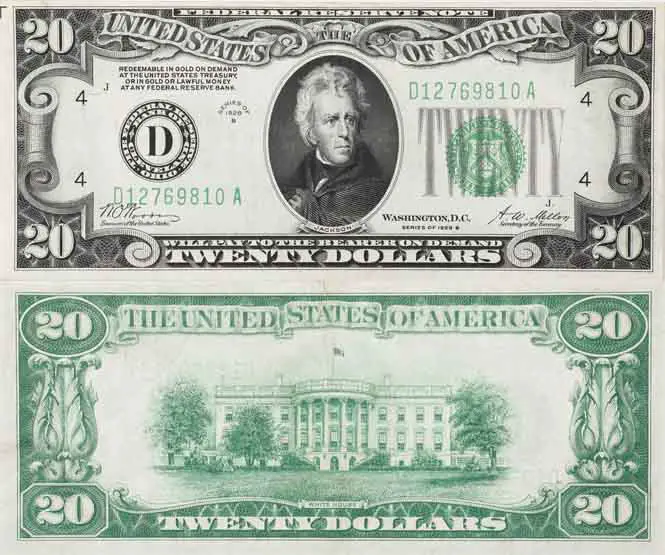
Image Courtesy of National Numismatic Collection at the Smithsonian Institution (Unedited CC)
1928 was the first year that the small sized note was introduced. It now measures 6.14 x 2.61 inches instead of the previous 7.375 x 3.125 inches.
These new $20 bills now feature the portrait of Andrew Jackson on the face and an image of the White House on the back.
Unlike their larger predecessors, they now have a green seal as opposed to a red or blue seal.
Initially the Federal Reserve Bank was represented by the District number inside a black seal on the original 1928 series $20 bill.
With the introduction of the 1928-B series and later, the Federal Reserve Bank is now represented by the District letter inside the black seal.
The obligation on the left hand side of the face states: REDEEMABLE IN GOLD ON DEMAND AT THE UNITED STATES TREASURY, OR IN GOLD OR LAWFUL MONEY AT ANY FEDERAL RESERVE BANK.
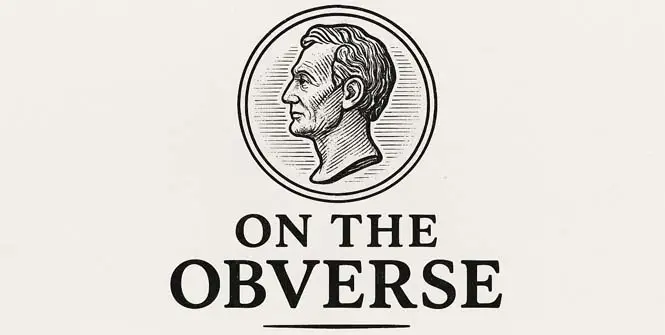
Would You Like To Receive More Exciting News And Information About Coin Collecting Direct To Your Inbox?
Enter your email address below, check the boxes and click Send It To Me! now to get your FREE copy of On The Obverse newsletter.


